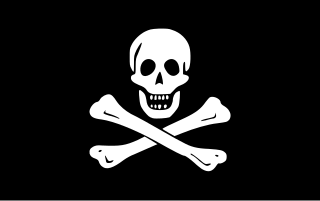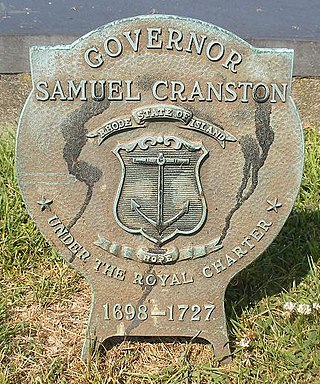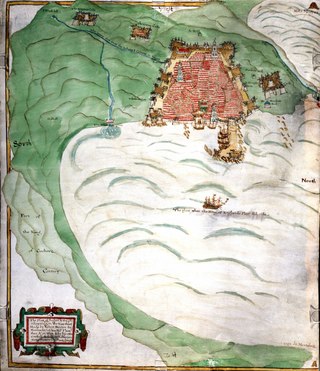Related Research Articles

Piracy is an act of robbery or criminal violence by ship or boat-borne attackers upon another ship or a coastal area, typically with the goal of stealing cargo and other valuable goods. Those who conduct acts of piracy are called pirates, and vessels used for piracy are called pirate ships. The earliest documented instances of piracy were in the 14th century BC, when the Sea Peoples, a group of ocean raiders, attacked the ships of the Aegean and Mediterranean civilisations. Narrow channels which funnel shipping into predictable routes have long created opportunities for piracy, as well as for privateering and commerce raiding.

A privateer is a private person or vessel which engages in maritime warfare under a commission of war. Since robbery under arms was a common aspect of seaborne trade, until the early 19th century all merchant ships carried arms. A sovereign or delegated authority issued commissions, also referred to as letters of marque, during wartime. The commission empowered the holder to carry on all forms of hostility permissible at sea by the usages of war. This included attacking foreign vessels and taking them as prizes and taking crews prisoner for exchange. Captured ships were subject to condemnation and sale under prize law, with the proceeds divided by percentage between the privateer's sponsors, shipowners, captains and crew. A percentage share usually went to the issuer of the commission.

A letter of marque and reprisal was a government license in the Age of Sail that authorized a private person, known as a privateer or corsair, to attack and capture vessels of a nation at war with the issuer. After capturing, the privateers could bring the case of that prize before their own admiralty court for condemnation and transfer of ownership to the privateer. A letter of marque and reprisal would include permission to cross an international border to conduct a reprisal and was authorized by an issuing jurisdiction to conduct reprisal operations outside its borders.
Benjamin Hornigold (1680–1719) was an English pirate who operated during the tail end of the Golden Age of Piracy.

Thomas Tew, also known as the Rhode Island Pirate, was a 17th-century English privateer-turned-pirate. He embarked on two major pirate voyages and met a bloody death on the second, and he pioneered the route which became known as the Pirate Round. Other infamous pirates in his path included Henry Avery and William Kidd.

The Golden Age of Piracy is a common designation for the period between the 1650s and the 1730s, when maritime piracy was a significant factor in the histories of the North Atlantic and Indian Oceans.
Alexander Dalzeel was a Scottish pirate and privateer who sailed in French service. Details on Dalzeel's early life - his career under pirate Henry Avery and exploits against the Spanish - appear only in Alexander Smith's 1720 collection "A Compleat history of the lives and robberies of the most notorious highwaymen," while his later activities are corroborated by newspaper accounts and trial records.
Edward Coates was a colonial American privateer in English service during King William's War and later a pirate operating in the Red Sea and Indian Ocean.

Samuel Cranston (1659–1727) was a governor of the Colony of Rhode Island and Providence Plantations during the first quarter of the 18th century. He held office from 1698 to 1727, being elected to office 30 times and served as governor longer than any other individual in the history of both the colony and the state of Rhode Island. The son of former Rhode Island Governor John Cranston, he was born in Newport and lived there his entire life. Going to sea as a young man, he was captured by pirates, and held captive for several years before returning to his family.

The Republic of Pirates was the base and stronghold of a loose confederacy run by privateers-turned-pirates in Nassau on New Providence island in the Bahamas during the Golden Age of Piracy for about twelve years from 1706 until 1718. While it was not a republic in a formal sense, it was governed by an informal pirate code, which dictated that the crews of the Republic would vote on the leadership of their ships and treat other pirate crews with civility. The term comes from Colin Woodard's book of the same name.
John Hoar was a pirate and privateer active in the late 1690s in the Red Sea area.
George Cusack was an Irish pirate active in northern Europe and the West Indies in the late 17th century.
James Allison was a pirate and former logwood hauler, active near Cape Verde and the Bay of Campeche. Almost the entire record of Allison's piracy comes from trial records of a single incident, the seizure of the merchantman Good Hope.
Cornelius Andreson was a Dutch pirate, privateer, and soldier. He is best known for attacking English traders off Acadia and for serving in King Philip’s War.
Nicholas Woodall was a pirate and smuggler active in the Caribbean. He is best known for his involvement with Charles Vane and Benjamin Hornigold.
Simon Mascarino was a Portuguese pirate active in the Caribbean. He was also a privateer in service of the Spanish.
John Nicolas Norcross was an English Jacobite pirate and privateer who sailed in service to Sweden.

The Proclamation for Suppressing of Pirates was a royal proclamation issued by George I of Great Britain on 5 September 1717. It promised a pardon for acts of piracy committed before the following 5 January to those pirates who surrendered themselves to the correct authority before a deadline. Originally, the surrender had to occur on or before 5 September 1718; this was later extended by a second proclamation to 1 July 1719.

The English Expedition to Algiers occurred between 1620 and 1621, it was a naval attack ordered by King James with the goal of ending Muslim piracy.
Thomas Vaughan was an Irish pirate and privateer who sailed for France during the Nine Years’ War. His trial was notable as a test of English common law against admiralty law.
References
- 1 2 Examinations of Pirates and Other Criminals. London: The National Archives. 1694. p. 166.
- 1 2 3 Clare, J (1694). An account of the tryals of Captain J. Golden. Thomas Jones. John Gold. Lawrance Maliene. Patrick Whitley. John Slaughter. Const. D'Heaity. Richard Shewers. Darby Collins. John Ryon. Dennis Cockram. John Walsh. At the Court of Admiralty held in the Marshalsea in Southwark, before the Right Honourable the Judges: on monday the 25th. of Feb. 1693/4. Of which 9 were found guilty, and received sentence of death: 3 for high treason, and 6 for piracies and roberys on the seas, under the colour of the late King James's commission. Licens'd Feb. 27th. 1693/4. London: The Globe. Retrieved 11 January 2018.
- ↑ Boon, Kristen (2011). Piracy and International Maritime Security. New York: Oxford University Press. pp. 67–68. ISBN 9780199758210 . Retrieved 11 January 2018.
- 1 2 3 Kay, Richard S. (2014). The Glorious Revolution and the Continuity of Law. Washington DC: CUA Press. ISBN 9780813226873 . Retrieved 11 January 2018.
- 1 2 3 Durston, Gregory (2017). The Admiralty Sessions, 1536-1834: Maritime Crime and the Silver Oar. Newcastle upon Tyne: Cambridge Scholars Publishing. pp. 164–165. ISBN 9781443873611 . Retrieved 11 January 2018.
- ↑ Neocleous, Mark (2016). The Universal Adversary: Security, Capital and 'The Enemies of All Mankind'. New York: Routledge. pp. 116–117. ISBN 9781317355434 . Retrieved 11 January 2018.
